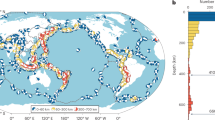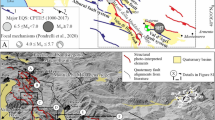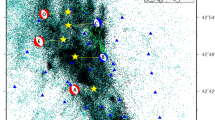Abstract
On 20 June 1978 at 20 h 03 min 23 s, an earthquake of surface wave magnitude 6.5 occurred in the Migdonian basin, between the Lagada and Volvi lakes, and 26 km from Thessaloniki. The main shock was preceded by a seismic sequence which started on 8 May. The largest earthquake of that sequence occurred on 23 May and had a surface wave magnitude of 5.8. The long duration of this sequence before the main shock of 20 June had tremendous psychological effects on the whole country. Greek seismologists were in a difficult position during that time (8 May–20 June), especially after the earthquake of 23 May, when pressed to state whether these earthquakes were foreshocks or aftershocks. Long-lasting seismic sequences with earthquakes of magnitude <6 are common in the Aegean area. Because these sequences are sometimes followed by large earthquakes it is important to see whether the latter can be predicted. The May–June 1978 seismic sequence provided the opportunity for testing hypotheses about statistical properties which, it has been suggested, could distinguish between foreshocks and aftershocks. This particular sequence has been investigated extensively1–4 and more accurate data are available than for any other sequence around Greece. Focal mechanism studies5,6 and field observations2 showed that the largest earthquakes of the sequence were produced by horizontal extension in a nearly north–south direction and that the main rupture occurred on a normal fault which strikes almost east–west and dips to the north. The fault length of the main shock of 20 June was estimated7 to be 32 km. Accurate determination of earthquake foci, using portable seismographs, showed that the earthquakes of this sequence were shallow (h<17 km) while the distribution of the epicentres had a very clear east–west elongation4,5. A migration of the seismic activity from east to west has also been observed between 8 May and 14 July. We investigate here the time variation of the average magnitude and the frequency of all the shocks with M ⩾ 3.0 of this sequence. The time variations of these seismic parameters are examined in connection with the distribution of well determined epicentres of 38 earthquakes with M ⩾ 4.3 in order to search for any premonitory pattern of the 23 May and 20 June major earthquakes.
This is a preview of subscription content, access via your institution
Access options
Subscribe to this journal
Receive 51 print issues and online access
$199.00 per year
only $3.90 per issue
Buy this article
- Purchase on SpringerLink
- Instant access to full article PDF
Prices may be subject to local taxes which are calculated during checkout
Similar content being viewed by others
References
Papazachos, B. C., Moundrakis, D., Psilovikos, A. & Leventakis, G. Tectonophysics 53, 171–183 (1979).
Mercier, J. L., Mouyaris, N., Simeakis, C., Roundojaynis, T. & Angelindhis, C. Nature 278, 45–48 (1979).
Carver, D. & Bollinger, G. A. Tectonophysics 73, 343–363 (1981).
Soufleris, C., Jackson, J. A., King, G. C. & Spencer, C. P. Geophys. J. R. astr. Soc. (in the press).
Papazachos, B. C., Moundrakis, D., Psilovikos, A. & Leventakis, G. Bulgar. geophys. J. 6, 72–80 (1978).
Soufleris, C. & Stewart, G. S. Geophys. J. R. astr. Soc. 67, 343–358 (1982).
Kulhanek, O. & Meyer, K. Special Volume on the Thessaloniki 1978 Earthquake (in the press).
Lee, W. H. K., Bennett, R. E. & Meagher, K. L. U.S. Geol. Surv. Open file Rep. (1972).
Suyehiro, S. Bull. seism. Soc. Am. 56, 185–200 (1966).
Papazachos, B. C., Delibasis, N., Liapis, N. & Moumoulidis, G. Ann. Geofys 20, 1–93 (1967).
Mogi, K. Bull. Earthq. Res. Inst. Tokyo 41, 595–614 (1963).
Scholz, C. H. Bull. seism. Soc. Am. 58, 399–415 (1968).
Scholz, C. H., Sykes, L. R. & Aggarwal, Y. P. Science 181, 803–809 (1973).
Papazachos, B. C. & Comninakis, P. E. Tectonophysics (in the press).
Hamilton, R. H. Bull. seism. Soc. Am. 58, 399–415 (1967).
Utsu, T. Bull. Hokkaido Univ. 13, 99–103 (1965).
Author information
Authors and Affiliations
Rights and permissions
About this article
Cite this article
Papazachos, B., Tsapanos, T. & Panagiotopoulos, D. A premonitory pattern of earthquakes in northern Greece. Nature 296, 232–235 (1982). https://doi.org/10.1038/296232a0
Received:
Accepted:
Issue date:
DOI: https://doi.org/10.1038/296232a0
This article is cited by
-
Precursory Activity Before Larger Events in Greece Revealed by Aggregated Seismicity Data
Pure and Applied Geophysics (2017)
-
Seismic sequences in Greece interpreted in terms of barrier model
Nature (1985)
-
Evidence for transform faulting in the Ionian sea: The Cephalonia island earthquake sequence of 1983
Pure and Applied Geophysics PAGEOPH (1985)



